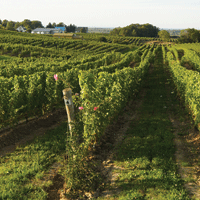The proof that Canadian wines are making great strides isn’t just in the glass; it’s also in the cash register. Dollar sales of Canadian wines have jumped almost 50 per cent during the past five years, while import sales grew by half as much, according to the Canadian Vintners Association.
Aggregate wine sales data in the restaurant industry aren’t available, so we spoke to restaurant owners and sommeliers who excel at promoting local wines in Ontario. We asked them for their views on the state of the industry and the innovative ways in which they promote
local vino at their establishments.
TOCA The Ritz-Carlton, Toronto
“Every month we feature a particular wine by the glass,” says Taylor Thompson, wine director at TOCA in Toronto. “Right now we’re pouring four Rieslings from around the world: one from Mosel, Germany; one from Alsace, France; and two from Niagara — Megalomaniac Reserve 2009 and Cave Spring CSV 2002.” At the end of each month, Thompson hosts a dinner with an Ontario winemaker, such as Cave Spring’s Angelo Pavan who recently led a vertical tasting of his wines from past vintages and Paul Pender of Tawse Winery for a Chardonnay Month Dinner.
Thompson also works with local wineries to create the restaurant’s own wine brand. “I’m very hands-on with our private label wines,” he says. “I’ll be visiting Huff Estate Winery in Prince Edward County this coming week and working with winemaker Frederic Picard on our TOCA Sparkling Wine. TOCA is very farm-to-table. We work as closely as possible with our farmers. We also have monthly visits from our sustainable suppliers, and they speak to our staff.”
TOCA has been open for just over a year and already a quarter of its wine sales are Canadian. The most popular varietals include Chardonnay, Riesling and Pinot Noir at all price points. It’s not uncommon to sell a bottle of Canadian wine for more than $200, according to Thompson. He believes the restaurant industry is an important partner to the local wine industry, particularly in helping new and small wineries get consumer recognition. Listing a broad selection of Canadian wines helps, but he doesn’t list cheap, low-quality wines that would reinforce that perception of Canadian wines. He worries about the development of inexpensive wine blends in Ontario that could hurt the industry’s reputation. “We need to work on what we do best to get the international recognition we deserve — nobody is upset with Burgundy for sticking to world-class Chardonnay and Pinot Noir.”
Bijou Restaurant, Stratford, Ont.
“We’ve always been active in promoting Canadian wines, especially with the Niagara region in our backyard,” says Bronwyn Linley, who owns Stratford, Ont.’s Bijou Restaurant with her chef-husband, Aaron. Almost all of the restaurant’s by-the-glass program highlights Canadian wines, not only from Niagara but also from Prince Edward County and British Columbia. The servers at Bijou are well-versed in Canadian wines and make an effort to spend time discussing them with customers. “We see a significant number of American tourists in Stratford and they are very eager to learn what we have to offer in Canada.”
Linley has worked hard to learn the product. “We’ve been open for 11 years and have always worked with local suppliers — this just makes sense,” she says. “Aaron shares the same relationship with our food suppliers as I do with the wineries.”
Canadian wine sales at the restaurant have skyrocketed, with most of the growth in white wines such as Sauvignon Blanc, Riesling, Chardonnay and Viognier. Red wines also sell well, but the ratio is about 2:1 for whites. The most popular price range per glass of still wine is $8 to $10, with icewines and late-harvest wines costing slightly more.
When it comes to innovation among Ontario wineries, Linley cites Reif Estates for its improved icewine production methods as well as Tawse for biodynamic farming and education. She adds that Brock University’s Cool Climate Oenology and Viticulture Institute in St. Catharines, Ont., is conducting critical innovative research on suitable grape varieties for Ontario and training the next generation of winemakers. “To convince customers we produce world-class wine, we need to get that wine in their glass. Once they take that first sip, then we can engage them because we have a great story to tell.”
Allen’s Restaurant, Toronto
“I find ‘winemakers dinners’ tiresome and consider the food-and-wine-matching syndrome pernicious as it formalizes wine and makes it inaccessible,” boldly says John Maxwell, owner and sommelier of Allen’s Restaurant in Toronto. Instead, he hosts Wine Evenings in the Backyard on the patio and invites a winemaker to select eight wines to present to interested patrons. “We promote these evenings [using] our email list, but there are no reservations, no cost and no requirement to buy any of the wines,” the owner says.
There are more than 100 Ontario wines on Maxwell’s list, and sales have grown by 20 per cent a year, with the most popular wines being those offered by the glass. In particular, Ontario wineries such as Hidden Bench, Karlo Estates, Huff Estate, John Howard, Stratus, Norm Hardie and 13th Street are strong sellers. The restaurant also has some rare treats, including Chardonnay Le Clos Jordanne 2004, the winery’s first vintage; Chardonnay VPR Peninsula Ridge; Tawse Robyn’s Block Chardonnay from the overlooked but excellent 2003 vintage; and the three 2003 Rieslings from Cave Spring Vineyards, described by winemaker, Angelo Pavan, as his finest Riesling.
Maxwell’s new initiative is to list his wines by Designated Viticultural Appellation or Sub-Appellation so customers can get familiar with smaller wine-producing regions within Ontario and British Columbia.
Petit Bill’s Bistro Ottawa
Just inside Ottawa’s Petit Bill’s is a wall dedicated to Ontario wine with a large map of the provincial wine regions, several plaques recognizing the restaurant with the VQA Award of Excellence and shelves with bottles of every Canadian wine ever served in the restaurant. Owner Randy Fitzpatrick says 40 per cent of his wine sales are from Ontario, and they’ve “grown by leaps and bounds,” especially Sauvignon Blanc, Chenin Blanc and Pinot Noir.
He believes winemaker dinners have been over-done and are a hard sell for what they’re worth. Instead, he offers three weekly table-card features with at least two Canadian VQA wines. Fitzpatrick is also an instructor teaching Algonquin College’s acclaimed sommelier certificate program in the city, so he knows the importance of server wine education. He encourages his staff to taste the Canadian wines on the list so they can talk about them knowledgably and with enthusiasm, and that has translated into stronger sales.
He’d like to see the LCBO allow special listings of Ontario wines at restaurants with little or no mark-up so customers can be introduced to local wines. He’d also like to see more tiers for the VQA’s Award of Excellence program for restaurants. There are currently two levels: the Award of Excellence for having 25 per cent or 25 listings of Ontario VQA wines and the Gold Award of Excellence for 75 per cent or more of Ontario VQA wines.
Trattoria Mercatto Toronto
Local wine is finding its place in global restaurants. “I came into my current role thinking the sun rose and set on Italian and French wines,” says Sheila Flaherty, wine director of Toronto’s Trattoria Mercatto, “but now our sales are made up by a large percentage of Ontario wines. We expected a good response, but it really has gone above and beyond what we could have imagined and continues to grow exponentially.”
Originally Trattoria Mercatto’s wine list spotlighted Italian wines that complemented the dishes. However, in October 2011, Flaherty launched a new list with local selections. “I began to recognize consumers wanted to buy locally — the 100-mile diet,” she observes. “Many other restaurants realize that, too.
I love going out now in Toronto and seeing a wine list comprised solely of local wines — feels very Old World to support your own.”
Popular Ontario wines on her list include Ravine Vineyards Meritage, Charles Baker’s Picone Riesling and Norm Hardie’s Pinot Noir. “They sell like hotcakes. Mind you, with only a 50 per cent markup on our wines, it also makes some of these special wines much more affordable for our guests.”
Flaherty also approves of the new virtual wineries such as Niagara’s 2027 Cellars and Nyarai Cellars, which make their wine at another winery’s facility. “At last, a way for local winemaking to begin without remortgaging their souls,” says Flaherty.
Moving forward, Mercatto’s list will highlight sustainable and ethically produced wine, a genre Tawse and Stratus have been commanding. “You can see the soul of this terroir now,” says Flaherty.
Keep Reading




















